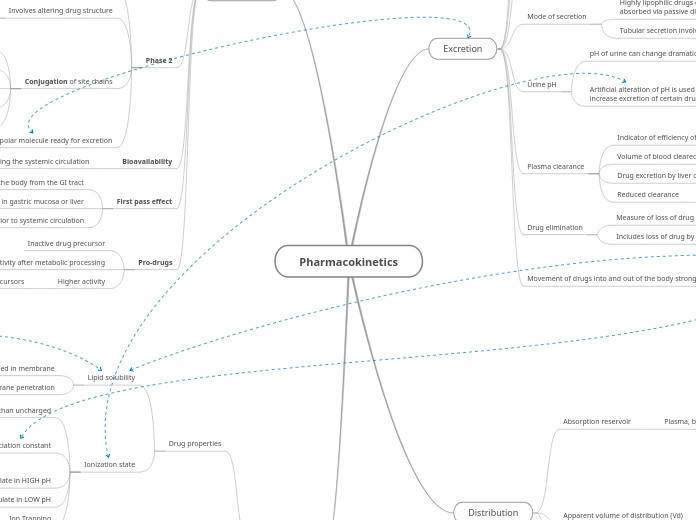Pharmacokinetics
Excretion
Most excretion occurs in kidneys
Drug clearance rate via renal greatly differ
Most drugs excreted in urine or bile (lesser extent)
Enterohepatic circulation
Account up to 20% of total drug in the body
Results in prolonged drug action
Drugs may be excreted in the bile after transport by the solute carriers and ABC transporters
Glomerular ultrafiltration
Level of plasma protein binding to drug
Plasma proteins too large to
pass renal luminal barrier
Retained in circulation
Drugs with high affinity protein slower excretion
Less free drug for filtration and diffusion
Small molecules readily pass and are cleared
Unbound fraction exhibits pharmacologic effects
Mode of secretion
Highly lipophilic drugs or non-ionized
absorbed via passive diffusion
Tubular secretion involve specific transporter proteins
Urine pH
pH of urine can change dramatically
Due to diet or drug intake
Artificial alteration of pH is used to
increase excretion of certain drugs
Ion trapping to increase drug retention in urine
Acidic urine increases basic drug excretion
Alkaline urine increases acidic drug excretion
Plasma clearance
Indicator of efficiency of drug removal from plasma
Clearance is a constant for any given drug
Volume of blood cleared of a drug through an organ per time
Drug excretion by liver or kidneys is best described by clearance
Reduced clearance
Indicative of function impairment of excretory organ
Drug elimination
Measure of loss of drug mass from the circulation per unit of time
Includes loss of drug by metabolism and any other excretory routes
Movement of drugs into and out of the body strongly influenced by:
Drug lipid solubility
Drug pKa
pH of the compartment
Distribution
Absorption reservoir
Plasma, body fat and interstitial water
Transcellular water ~2%
Comprises CSF, intraocular, peritoneal, pleural and synovial fluids and digestive secretions
Plasma water ~5%
Interstitial water ~16%
Intracellular water ~35%
Fat ~20%
Apparent volume of distribution (Vd)
Dose divided by measured plasma concentration
Gives estimate where drug is (tissues or circulation)
Drug with very low Vd likely to still be in circulation
Large Vd drug likely to enter body compartment
Endothelial cells
Fenestrations
Gaps that allow solute diffusion
Blood brain barrier
Molecule must pass through at least 2 membranes
Highly lipophilic drugs able to readily pass through
Active transport by carriers
AA, glucose, amines and purines
Diffusion is PRIMARY for drugs crossing BBB
Metabolism
Phase 1
Oxidation (also reduction and hydrolysis)
Mediated by cytochrome system associated with ER
Most common residue is hydroxyl
Mainly in liver
Hepatic cytoplasmic microsomal enzymes
E.g. cytochrome systems
Can also occur in other tissues or plasma
Nonpolar drugs go through phase 1 more than polar
Need to cross cell membrane to reach cytochrome systems
Cytochrome system
3 main CYP gene families
CYP1
CYP2
CYP3
Net effect of cytochrome p450 cycle
is addition of oxygen or hydroxyl
Genetic variations exist
Primary cause of patient response variation
P450 enzyme levels regulated by external factors
E.g. grapefruit juice and Brussels sprouts
Metabolic enzymes generally alter drugs to activate them and make them more water soluble
Phase 2
Mainly in the liver
Can also occur in other tissues like lungs and kidneys
Involves altering drug structure
Reduce intrinsic efficacy for excretion
Normally results in inactive product (some exceptions)
Conjugation of site chains
Glucuronidation
Sulphation
Glutathione addition
Methylation
Glycine or water addition
Produces polar molecule ready for excretion
Bioavailability
Amount of drug reaching the systemic circulation
First pass effect
Almost all drugs entering the body from the GI tract
Occur in gastric mucosa or liver
Reduces bioavailability prior to systemic circulation
Pro-drugs
Inactive drug precursor
Gain full drug activity after metabolic processing
Higher activity
Different absorption or distribution properties than precursors
Absorption
Drug properties
Lipid solubility
Too lipid-soluble = retained in membrane
High soluble = higher membrane penetration
Ionization state
Ionized dissolve aqueous fluids than uncharged
Dissociation constant
Ratio between dissociated ions and drug
Negative value = greater proportion
of non-ionized drug
Greater lipid solubility
Acidic drug will accumulate in HIGH pH
Basic drug will accumulate in LOW pH
Ion Trapping
Drug's ionization preference and retention
Active transport
Specific carriers
ABC transporters
Specialized membrane proteins
Transport AGAINST concentration gradients
E.g. P‐glycoprotein transporters
Primary group of ABC transporters
Mediate removal of drugs from cells
Pinocytosis
Passive movement
Diffusion is the mechanism used by most drugs
Facilitated diffusion is passive with no energy
Aquaporins
Solute carrier
Facilitates transport single species IN THE DIRECTION of its electrochemical gradient
E.g. Organic cation transporters
Mediate the movement of dopamine and choline
